Armadillos | Characteristics, Behaviour, 10 Types, Care Tips
Ever wondered about armadillos? These fascinating creatures, sporting armor-like plating, have captivated nature enthusiasts and scientists alike. In this guide, we explore their diverse species, behaviours, and habitat roles. Discover nocturnal secrets, adaptation wonders, and their contributions to ecosystems. Whether you’re a researcher or simply intrigued by these armoured marvels, this article opens the door to the captivating life of armadillos. Embark on a journey that unveils their mysteries and sheds light on their crucial ecological role.
Armadillo
Have you ever come across an animal that seems to have its own built-in armour? Armadillos fit that description perfectly. These intriguing creatures are nature’s way of combining toughness and adaptability into one unique package.
Unveiling the Armadillo’s Mystique:
Armadillos hail from the Americas, and their most distinctive feature is their protective shell-like armour. It’s like they’re wearing a mini-suit of armour that covers their bodies. But don’t let the armour fool you; these animals are more than just tough exteriors.
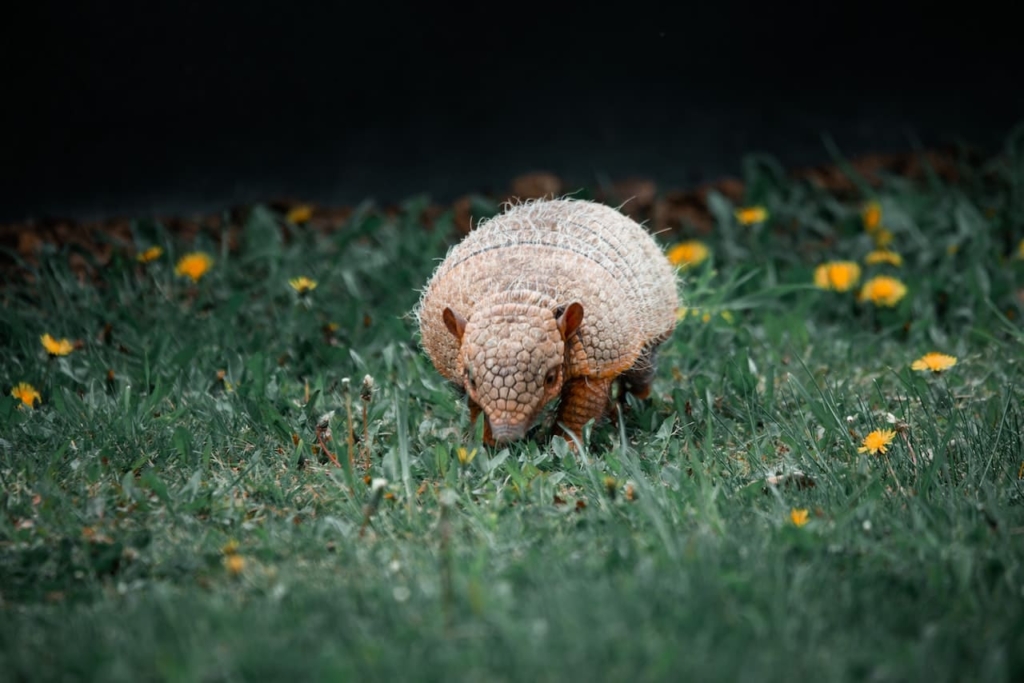
Diverse and Adaptable:
Armadillos aren’t your average creatures; they’re adaptable survivors. You’ll find them in a range of habitats, from grasslands to forests, and even in deserts. Their adaptability is a result of their skillful digging and burrowing capabilities, which help them find shelter and food.
Unraveling Their Behavior:
Have you ever wondered how armadillos behave? Well, they’re primarily nocturnal, meaning they’re most active at night. They have an impressive sense of smell that helps them locate their favourite snacks – insects, beetles, and termites. And when it comes to danger, armadillos have a nifty trick up their armoured sleeves: they can roll themselves into a tight ball, providing an almost impenetrable shield against predators.
Beyond the Shell:
While their armour steals the spotlight, armadillos have other interesting aspects too. They’re known for their peculiar way of giving birth – instead of laying eggs, they bring forth live young. This reproductive strategy sets them apart from most other mammals.
Armadillos and Us:
Armadillos have even made their way into human culture and daily life. From their appearance in local folklore to their influence on scientific research, they’re more intertwined with our world than we might realize.

Conservation Concerns:
While armadillos as a whole aren’t endangered, certain species might face challenges due to habitat loss and other factors. It’s a reminder of the delicate balance that exists in the natural world and the importance of protecting biodiversity.
Getting to Know Armadillos:
These captivating creatures have a lot more to offer than meets the eye. Their armour, behaviour, and unique traits have fascinated scientists and nature enthusiasts for years. So, the next time you come across an armadillo, take a moment to appreciate the remarkable balance of strength and gentleness that they bring to the world.
Baby Armadillo
Baby armadillos, resembling tiny versions of their adult counterparts, enter the world with an endearing charm. These miniature creatures possess a softness that belies the toughness of their future armour. As they grow, their skin transforms into the iconic armoured plates that serve as their primary defense against predators and environmental challenges.
Armadillo Lizard
The armadillo lizard, scientifically classified as Cordylus cataphractus, is a captivating reptile that draws parallels to its distant cousin, the armadillo. Native to South Africa, this lizard’s defining feature is its intricate armour of bony scales, reminiscent of the armadillo’s plating. Mirroring the armadillo’s defense strategy, the armadillo lizard can curl into a protective ball, highlighting the remarkable convergence of adaptations across species.
Armadillo Girdled Lizard
Inhabiting the rugged terrains of Southern Africa, the armadillo girdled lizard (Cordylus matthesae) is an exemplar of survival strategies. When threatened, this lizard encircles itself with its own tail, forming a defensive barrier. This unique behavior showcases the lizard’s ability to creatively adapt to its surroundings, underscoring the diverse array of survival tactics in the animal kingdom.
Pink Fairy Armadillo
The pink fairy armadillo (Chlamyphorus truncatus) stands as a testament to nature’s artistic palette. Residing in the arid landscapes of South America, its delicate pink hue captures attention. Despite its dainty appearance, this armadillo species is a proficient burrower, using its specialized claws to tunnel through the sand. The juxtaposition of fragility and resilience in the pink fairy armadillo is a marvel of adaptation.
Giant Armadillo
The giant armadillo (Priodontes maximus) emerges as a colossal member of the armadillo family. With a potential weight exceeding 70 pounds and a length surpassing three feet, this species commands attention. Its robust armor and size make it a distinctive figure in its native South American habitats. Beyond its awe-inspiring appearance, the giant armadillo’s ecological role showcases the interconnectedness of species within ecosystems.

3 Banded Armadillo
The three-banded armadillo (Tolypeutes tricinctus) presents an intriguing study in defense mechanisms. Its extraordinary ability to curl into a tight ball, shielding itself from predators, is an evolutionary feat. Native to parts of the Americas, this armadillo’s adaptable traits serve as a testament to nature’s innovation in equipping creatures to navigate complex landscapes.
9 Banded Armadillos
The nine-banded armadillo (Dasypus novemcinctus) boasts remarkable versatility in its adaptability. With its segmented armor and strong digging capabilities, this armadillo species constructs intricate burrows that serve as shelters and hunting grounds. Found across the Americas, its resilience in varying environments underscores the species’ capacity to flourish through changing conditions.

Brazilian Three Banded Armadillo
The Brazilian three-banded armadillo (Tolypeutes tricinctus) showcases an astonishing defense strategy. When under threat, it contracts into a complete ball, leaving predators with virtually no vulnerabilities to exploit. Endemic to the dry expanses of Brazil, this armadillo species exemplifies the extraordinary ways creatures evolve to outsmart their adversaries.
Armadillos In Tennessee
The presence of armadillos in Tennessee reflects a remarkable phenomenon driven by environmental shifts. Historically absent from this region, armadillo are extending their range northward due to changing climate patterns. This migration’s implications for local ecosystems and species interactions underscore the intricate web of connections that shape biodiversity.
Pangolin Armadillo
The concept of a pangolin armadillo underscores the intriguing principle of convergent evolution. Despite being separate biological families, pangolins and armadillos share the parallel adaptation of protective armor. This captivating example of evolutionary resemblance offers insights into the pressures that shape creatures across different lineages.

Screaming Hairy Armadillo
The screaming hairy armadillo (Chaetophractus vellerosus) combines a vivid name with intriguing attributes. Found in South America, this small armadillo emits vocalizations when threatened, earning its expressive label. With its thick coat of hair, it distinguishes itself from other armadillo species, showcasing the diversity of adaptations within this family.
Armadillo Anteater
Armadillo anteaters offer a fascinating glimpse into specialized diets within the armadillo family. These creatures have evolved to be adept ant and termite hunters, equipped with features such as sharp claws and a keen sense of smell. Exploring their unique adaptations reveals the remarkable lengths to which species can go to exploit specific ecological niches.
Hairy Armadillo
The hairy armadillo (Chaetophractus villosus) stands out for its distinctive appearance. Covered in bristle-like hairs, it presents a departure from the smooth-shelled armadillos. Native to South America, the hairy armadillo’s adaptations and behaviours serve as a testament to the wide spectrum of strategies animals use to thrive in various habitats.

Armadillo Florida
Armadillos’ introduction to Florida’s ecosystems offers a captivating study in species interactions. As these armored creatures establish themselves in new territories, they interact with native flora and fauna in ways that shape the delicate balance of local ecosystems. This expansion highlights the need for understanding and managing the complex relationships that define biodiversity.
Armadillo Texas
Armadillos in Texas encapsulate the state’s diverse landscapes and the species’ adaptability to various habitats. From woodlands to grasslands, these creatures thrive in environments that span the state. Studying armadillos in Texas sheds light on the intricate connections between wildlife and geography, emphasizing the importance of preserving these relationships.

Armadillos In Georgia
Armadillos extending their range to Georgia reflects the dynamic nature of species distributions. As these creatures migrate and adapt, their presence prompts questions about their interactions with local species and ecosystems. The expansion of armadillo into Georgia serves as a living example of the interplay between species and their ever-changing environments.
Pangolin Vs Armadillo
Comparison and differences between pangolins and armadillos:
| Aspect | Pangolins | Armadillos |
|---|---|---|
| Family | Pholidota | Dasypodidae |
| Habitat | Found in Asia and Sub-Saharan Africa | Native to the Americas |
| Armor | Covered in keratin scales, resembling armor | Bony plates (“scutes”) cover the body |
| Behaviour | Nocturnal and solitary; roll into a ball | Nocturnal, some species roll into a ball |
| Diet | Mainly ants and termites; insectivorous | Insects, small invertebrates, some plant matter |
| Limbs | Four legs; long claws for digging | Four legs; strong digging claws |
| Reproduction | Live births, usually one offspring at a time | Live births, multiple offspring in a litter |
10 Types Of Armadillo
Armadillos, with their distinct armoured appearance and intriguing behaviours, encompass a diverse array of species. Each type of armadillo presents its own set of characteristics and adaptations that have allowed them to thrive in various environments. Let’s delve into some of the notable types of armadillo:
- Nine-Banded Armadillo (Dasypus novemcinctus): This species is one of the most recognized armadillos, known for its segmented armour and ability to jump several feet in the air when startled. Found in North, Central, and South America, it’s an adaptable species that has managed to coexist with human activities.
- Giant Armadillo (Priodontes maximus): As the largest of the armadillo species, the giant armadillo resides in South America. Its massive size and distinctive appearance make it a captivating subject of study. Despite its imposing presence, this armadillo is a critical part of its ecosystem, contributing to soil health and seed dispersal.
- Three-Banded Armadillo (Tolypeutes species): With a unique defense strategy, the three-banded armadillo can curl its body into an almost impenetrable ball. Native to South America, this species showcases the remarkable ways animals adapt to safeguard themselves against predators.
- Pink Fairy Armadillo (Chlamyphorus truncatus): Native to Argentina, this species stands out with its delicate pink hue and small size. It’s a proficient burrower, using its specialized claws to dig through sandy soils in search of insects. Its appearance contrasts with its ability to thrive in harsh desert conditions.
- Six-Banded Armadillo (Euphractus sexcinctus): This armadillo species, also known as the yellow armadillo, is found in South America. Its armor features distinct bands that cover its body, and it is known for its keen sense of smell, which aids in locating its preferred diet of insects.
- Southern Three-Banded Armadillo (Tolypeutes matacus): Like its relative, the three-banded armadillo, this species can curl into a ball when threatened. Native to South America, it’s recognized for its specialized behaviors and is a popular subject of scientific research.
- Brazilian Long-Nosed Armadillo (Dasypus septemcinctus): As an inhabitant of the rainforests of South America, this species possesses a long, pointed snout adapted for digging and foraging. It plays a role in forest ecology by dispersing seeds as it moves through its habitat.
- Northern Naked-Tailed Armadillo (Cabassous centralis): This armadillo species is known for its unique appearance – it lacks the armored plating on its tail, giving it a “naked” appearance. Native to Central America, it’s an excellent digger, constructing burrows that are used for shelter and reproduction.
- Andean Hairy Armadillo (Chaetophractus nationi): Found in the Andes region of South America, this species has a distinctive hairy appearance. Its dense coat of bristles sets it apart from its smoother-armored relatives, showcasing the diversity within the armadillo family.
- Pichi Armadillo (Zaedyus pichiy): Residing in South America, the pichi armadillo has a rounded body shape and is known for its keen sense of hearing. It’s a nocturnal creature, foraging for insects and other small prey under the cover of darkness.
Armadillo Pronunciation
Understanding the pronunciation of “armadillo” can add to the familiarity with this unique creature. The word is pronounced as “ahr-muh-DIL-oh,” with the stress on the second syllable. The first syllable has a short “a” sound, and the second syllable rhymes with “pillow.”
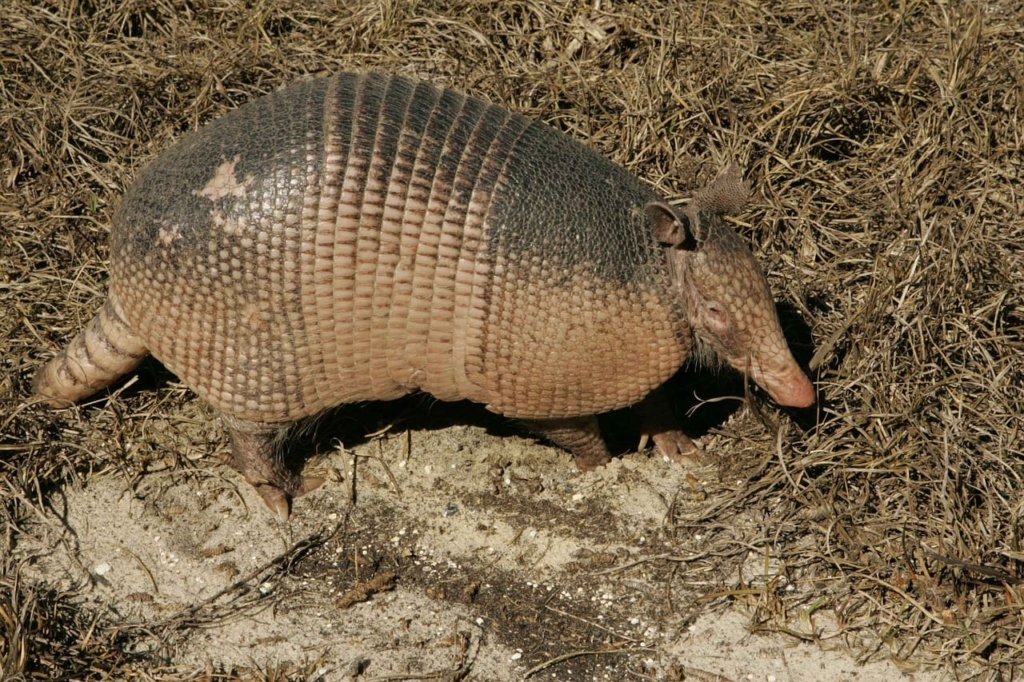
Armadillo Meaning In Hindi
In Hindi, “armadillo” is translated as “अर्माडिलो.” This term captures the essence of these armored creatures that are known for their bony plates. Understanding the meaning in Hindi enriches cross-cultural discussions about armadillos and their unique characteristics.
Armadillo Meaning In Bengali
In Bengali, “armadillo” is rendered as “আরমাদিলো.” This translation encapsulates the essence of these intriguing animals that possess a distinct armor-like plating. Knowing the meaning in Bengali adds depth to conversations about armadillos in diverse linguistic contexts.
Armadillo In Tamil
In Tamil, the term for “armadillo” is “ஆர்மடிலோ.” This word brings to mind the image of these armored mammals, renowned for their unique protective features. Understanding the term in Tamil facilitates communication about armadillos within Tamil-speaking communities.
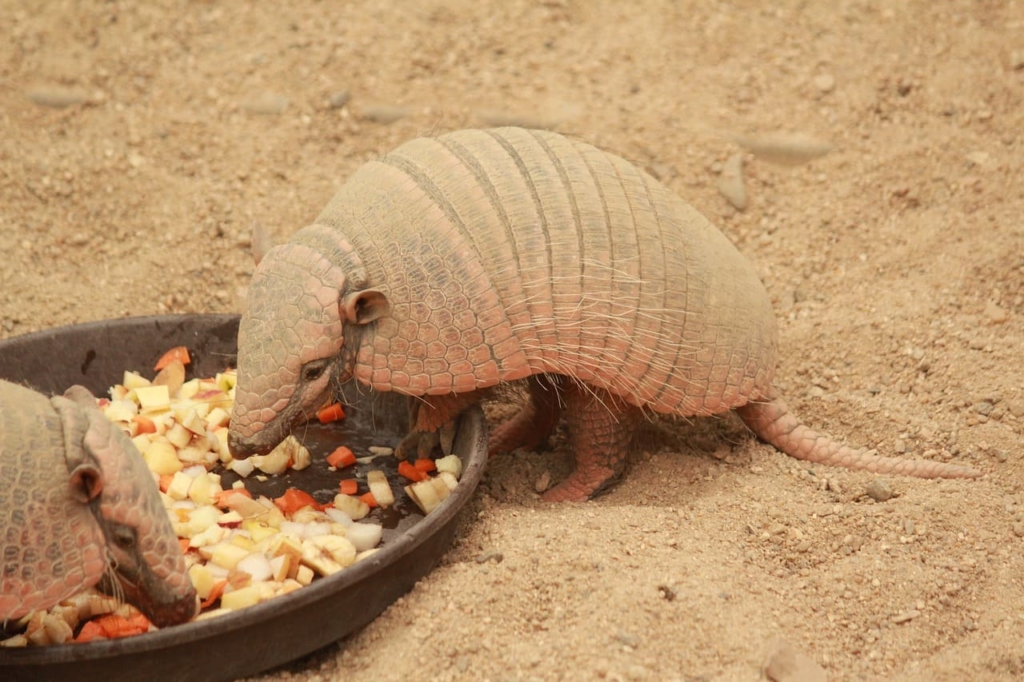
Armadillo Meaning In Malayalam
The Malayalam translation for “armadillo” is “അർമാഡില്ലോ.” This translation aptly captures the essence of these creatures known for their protective armor. Knowing the meaning in Malayalam enhances the ability to discuss armadillo in a Malayalam-speaking context.
Armadillo In Marathi
In Marathi, “armadillo” is referred to as “आर्मडिलो.” This term encapsulates the unique features of these animals, particularly their armored plating. Familiarity with the Marathi term enables discussions about armadillos in Marathi-speaking regions.
Armadillo In Pakistan
While not native to Pakistan, armadillo can sometimes be found in zoos or as exotic pets. The introduction of armadillo to Pakistan might involve wildlife centers or zoological institutions. Due to the lack of a direct local term, the English term “armadillo” is often used to refer to these animals in Pakistan.
Armadillo In Telugu
In Telugu, “armadillo” is expressed as “ఆర్మడిలో.” This translation encapsulates the essence of these creatures, celebrated for their distinctive armoured appearance. Understanding the term in Telugu facilitates discussions about armadillo within Telugu-speaking communities.
History of Armadillo
The history of armadillos traces back millions of years to the prehistoric era. Fossil records suggest that armadillo-like creatures existed during the age of the dinosaurs. Native to the Americas, these remarkable mammals have adapted and evolved over time to inhabit a variety of environments, becoming a symbol of resilience in the face of changing landscapes.
Appearance of Armadillo
The appearance of an armadillo is characterized by its unique armor-like plating. Their bodies are covered in bony plates called “scutes” that provide protection against predators. The arrangement of these scutes varies among different armadillo species, contributing to the diversity in their appearances. Their small eyes and pointed snouts are adaptations to their predominantly insectivorous diet.

Temperament of Armadillo
The temperament of armadillos is typically shy and solitary. These nocturnal creatures are known for their preference for solitude and are often observed foraging for food alone during the night. When confronted with danger, armadillos may exhibit defensive behaviours, such as rolling into a ball or digging into the ground for safety.
Behaviour of Armadillo
The behavior of armadillos is marked by their digging and burrowing habits. They are skilled diggers, using their strong claws to excavate burrows for shelter and foraging. Their sense of smell guides them to their primary diet of insects, larvae, and small invertebrates. Armadillo are also known for their ability to roll into a tight ball when threatened, presenting predators with a tough, impenetrable exterior.
Armadillo Eggs
Armadillos do not lay eggs; they give birth to live young. This unique reproductive trait is rare among mammals and sets armadillo apart from other animals. The number of offspring in a litter varies among species, with some armadillo mothers giving birth to as many as nine pups in a single pregnancy.
Trapping A Armadillo
Trapping an armadillo requires careful planning and adherence to local regulations. Live traps are commonly used, baited with foods that armadillos are attracted to. It’s important to consider the animal’s welfare and safety during trapping. Once caught, relocation to a suitable environment far from human habitation is recommended.
Armadillo Disease
Armadillos are carriers of the bacterium Mycobacterium leprae, which causes leprosy in humans. However, transmission of leprosy from armadillo to humans is extremely rare. It’s advisable to avoid handling armadillo, particularly in regions where leprosy is a concern.

Armadillos For Pets
While armadillos might seem intriguing, they are not suitable as pets. Their specialized care requirements, natural behaviours, and potential for carrying diseases make them unsuitable companions for domestic settings. It’s important to appreciate armadillo in their natural habitats rather than attempting to keep them as pets.
Armadillo Diet
Armadillos are opportunistic feeders with a primarily insectivorous diet. They use their keen sense of smell to locate ants, termites, beetles, and other small invertebrates. In addition to insects, they may consume plant matter and even small vertebrates on occasion. Their diet varies based on the availability of food in their habitat.
Armadillo Ball
The “armadillo ball” refers to the iconic defensive behaviour of certain armadillo species. When threatened, these armadillo curl into a tight ball, protecting their vulnerable underside with their tough, armored exterior. This behaviour serves as an effective deterrent against predators.
Armadillo Habitat
Armadillos inhabit a range of environments, including grasslands, forests, and deserts. They are particularly skilled at adapting to different habitats due to their digging abilities and varied diet. Armadillo burrows provide shelter from extreme temperatures and predators, showcasing their remarkable adaptation to diverse ecosystems.
Armadillo Skeleton
The armadillo’s skeleton is notable for its fused bony plates, which form the protective armor covering its body. This feature, along with their specialized adaptations, has allowed armadillos to succeed in a variety of habitats. Their skeleton is a testament to the evolutionary processes that have shaped their unique physiology.
Are Armadillos Endangered
As a whole, armadillo populations are not considered endangered. However, some individual species may face threats due to habitat loss, hunting, and road accidents. Conservation efforts may be necessary to ensure the survival of specific armadillo species in vulnerable regions.
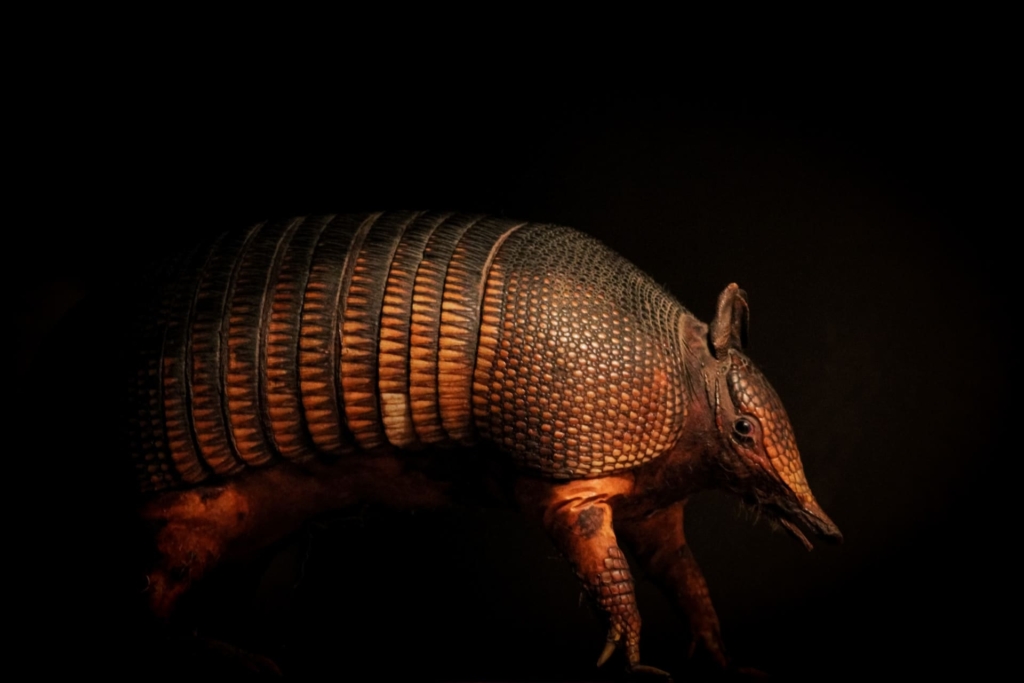
Can Armadillos Swim
Yes, armadillos are capable swimmers. Their buoyant bodies and paddle-like limbs enable them to navigate through water. In search of food or while crossing water bodies, armadillo can swim effectively using their natural adaptations.
Armadillo Repellent
Various commercial and homemade repellents are available to deter armadillos from areas where they are unwanted. These repellents often include strong scents or taste aversions that armadillo find unpleasant.

Do Armadillos Hibernate
Armadillos do not hibernate in the traditional sense. However, in colder months, they may enter a state of torpor, where their metabolic rate decreases to conserve energy. They may also reduce their activity during extreme weather conditions, emerging when temperatures are more favorable for foraging.
Are Armadillos Carnivores
Armadillos are omnivores, with their diets consisting primarily of insects, larvae, and small invertebrates. While they have a strong affinity for insects, they may also consume plant matter and small vertebrates, showcasing their adaptable eating habits.
Are Armadillos Mammals
Yes, armadillos are mammals. They belong to the class Mammalia and share characteristic features with other mammals, such as giving birth to live young, having hair or fur, and producing milk to nourish their offspring.
Armadillo Facts
Interesting and informative armadillo facts:
- Ancient Origins: Armadillo are among the oldest mammals on Earth, with their ancestors dating back around 60 million years.
- Armor Arrangement: Armadillo’s unique armor is made up of plates called scutes. These scutes cover the head, back, and tail, providing protection against predators.
- Rolling into a Ball: While not all armadillo species can roll into a ball, some, like the three-banded armadillo, have this incredible defensive behaviour to shield their vulnerable underside from threats.
- Varied Diet: Armadillos are insectivores, primarily feeding on ants, termites, beetles, and other small invertebrates. Some species also consume fruits and vegetation.
- Adapted to Digging: With strong and clawed front limbs, armadillo are adept diggers. They excavate burrows for shelter, food storage, and raising their young.
- Multiple Offspring: Most armadillo species give birth to multiple offspring in a single litter. The number can range from one to as many as nine, depending on the species.
- Varying Reproductive Strategies: Armadillos exhibit diverse reproductive strategies. Some species give birth to fully developed young, while others have a delayed implantation process, allowing them to time births with optimal environmental conditions.
- Unique Birth Process: Armadillos are one of the few mammals that give birth to identical quadruplets. All offspring in a litter are genetically identical, making them natural clones.
- Nocturnal Habits: Armadillo are predominantly nocturnal, being most active during the night. This behaviour helps them avoid predators and the heat of the day.
- Conservation Concerns: Some armadillo species are threatened due to habitat loss, hunting, and road accidents. These factors contribute to their conservation status in specific regions.
- Role in Ecosystems: Armadillo are ecosystem engineers, as their digging activities help aerate soil, increase water infiltration, and disperse seeds. They have a positive impact on their environments.
- Range Expansion: Certain armadillo species, such as the nine-banded armadillo, have expanded their range northward into regions where they were historically absent due to changing climate patterns.
- Limited Vision: Armadillo have poor eyesight, relying more on their sense of smell to navigate and locate food.
- Can Armadillos Swim?: Yes, armadillo are capable swimmers. They use their buoyant bodies and paddle-like limbs to move through water.
- A Close Relative: The extinct glyptodonts, which lived during the Ice Age, were distant relatives of armadillo. They were massive creatures with heavily armored shells.
Pros and Cons of Armadillo
Some common pros and cons of armadillos:
| Pros of Armadillos | Cons of Armadillos |
|---|---|
| Natural Pest Controllers: Armadillo feed on insects, helping control pest populations in their habitats. | Vehicle Collisions: Armadillo can be hit by vehicles, especially when crossing roads, leading to roadkill. |
| Seed Dispersal: Armadillo aid in seed dispersal through their digging activities, contributing to plant growth. | Disease Concerns: Armadillo can carry diseases like leprosy, raising potential health risks to humans. |
| Soil Aeration: Their digging and burrowing activities aerate the soil, benefiting plant growth and ecosystems. | Habitat Disturbance: Extensive burrowing can disturb landscapes and impact other species’ habitats. |
| Research Value: Studying armadillo’ unique reproductive strategies and armor can provide insights into evolution and adaptation. | Potential Predation: While their armor offers protection, some predators can still exploit vulnerabilities, impacting armadillo populations. |
| Conservation Flagship: Some armadillo species serve as flagship species, drawing attention to conservation efforts for their habitats. | Human-Wildlife Conflict: Armadillos may dig up lawns and gardens, causing frustration for property owners. |
Care Tips for Armadillo
Caring for armadillo, whether in the wild or under human care, requires attention to their unique needs:
- Habitat Preservation: In the wild, armadillo thrive when their natural habitats are protected. Preserving their ecosystems ensures their access to food, shelter, and suitable environments.
- Minimize Human Interaction: Armadillo are wild animals and can become stressed when in close contact with humans. If you encounter an armadillo, observe from a distance to avoid causing unnecessary stress.
- Avoid Feeding: Feeding armadillo can lead to dependence on humans and alter their natural behaviours. It’s best to allow them to find their own food in their habitat.
- Provide Safe Crossings: If you live in an area with armadillo, consider installing wildlife-friendly road crossings to reduce the risk of vehicle collisions.
- Address Habitat Disturbances: If armadillos are digging up lawns or gardens, consider landscaping solutions that deter them without causing harm.
- Avoid Captivity: Keeping armadillo as pets is discouraged due to their specific needs and potential legal restrictions. Wild animals belong in their natural habitats.

Health Issues of Armadillo
Armadillos, like all animals, can face health challenges:
- Leprosy Transmission: Some armadillo carry Mycobacterium leprae, the bacterium causing leprosy in humans. Avoid handling armadillo to reduce the risk of transmission.
- External Parasites: Armadillos can harbor external parasites such as ticks and fleas. These parasites can affect their health and may carry diseases.
- Injuries: Vehicle collisions, predator attacks, and habitat disturbances can lead to injuries for armadillos in the wild.
- Stress: Human interaction and habitat disruption can cause stress in armadillo, impacting their overall well-being.
Armadillo Lifespan
In their natural habitats, armadillo’ lifespans can range from 4 to 30 years, depending on factors such as species, habitat quality, and predation.
Food for Armadillo
Best and suitable food options for armadillos:
| Type of Food | Examples |
|---|---|
| Insects: | Ants, termites, beetles, crickets, worms |
| Larvae: | Beetle larvae, moth larvae, termite larvae |
| Small Invertebrates: | Spiders, snails, slugs, small crustaceans |
| Plant Matter: | Fruits, berries, tender plant shoots, fungi |
| Occasional Animal Protein: | Small vertebrates like frogs, lizards |
| Carrion: | Scavenging on animal carcasses (opportunistic) |
| Supplementary Foods: | High-protein pet foods, mealworms, commercially available insect-based diets |
Armadillo Video
Conclusion:
In conclusion, armadillos stand as fascinating creatures with unique attributes that have allowed them to thrive across diverse habitats. From their distinct armor and intriguing behaviours to their role in ecosystem dynamics, armadillo exemplify the wonders of nature’s adaptations. While their presence brings both benefits and challenges, understanding their needs and interactions fosters a harmonious coexistence between these remarkable animals and the environments they inhabit. As we appreciate their resilience and contribution to the natural world, it’s vital to approach armadillo with care, respect, and a commitment to their well-being and conservation.
Frequently Asked Questions on Armadillo:
What Is Armadillo
An armadillo is a unique mammal known for its distinct appearance characterized by a tough, bony shell covering its body. Belonging to the order Cingulata, armadillos are native to the Americas and are recognized for their ability to roll into a ball when threatened, offering them protection from predators. The name “armadillo” originates from Spanish and Portuguese words meaning “little armored one.”
What Do Armadillos Eat
Armadillos are omnivorous animals with a varied diet that varies by species and habitat. The primary components of their diet are insects and invertebrates such as ants, termites, beetles, and earthworms. In addition to their insectivorous diet, armadillo also consume small vertebrates, amphibians, and fruits. Their diet can vary depending on factors such as availability and environmental conditions.
Do Armadillos Carry Leprosy
Yes, some armadillo species, particularly the Nine-banded Armadillo (Dasypus novemcinctus), have been found to carry the bacterium Mycobacterium leprae, which is responsible for leprosy in humans. However, the transmission of leprosy from armadillo to humans is considered rare and generally requires prolonged and close contact with infected animals.
How To Get Rid Of Armadillos
To manage armadillo presence on your property, consider implementing various strategies. These may include removing potential food sources such as insects and grubs, using physical barriers like fences or exclusion nets to prevent access, using repellents, installing motion-activated devices, and employing humane trapping methods. Consulting with wildlife experts can help you determine the best approach based on your specific situation.
Are Armadillos Dangerous
Armadillos are not typically dangerous to humans. They are not aggressive animals and will often retreat or dig into the ground when they feel threatened. However, there are potential risks associated with armadillo contact, such as diseases they may carry, so it’s advised to avoid direct interaction.
Where Do Armadillos Live
Armadillos inhabit a diverse range of environments across the Americas. They are found in habitats including grasslands, forests, savannas, deserts, and even urban areas. Armadillo are particularly well adapted to regions with loose soil, which allows them to use their strong claws for digging burrows and foraging for food.
Are Armadillos Nocturnal
Yes, most armadillo species are primarily nocturnal, meaning they are most active during the nighttime. This behavior helps them avoid the heat of the day and reduce their exposure to potential predators.
Can You Eat Armadillo
Yes, armadillo meat has been consumed in some cultures, particularly in parts of Central and South America. However, caution should be exercised as armadillo can carry diseases that may be transmitted to humans through consumption.
Do Armadillos Bite
Armadillos may bite if they feel threatened, cornered, or provoked. However, their bites are not typically strong or powerful enough to cause significant harm to humans.
Do Armadillos Lay Eggs
No, armadillos are not egg-laying animals. They give birth to live young, with the number of offspring varying among species.
Are Armadillos Mammals
Yes, armadillos are mammals. They are part of the class Mammalia and share common characteristics such as giving birth to live young, having mammary glands to nurse their offspring, and being warm-blooded.
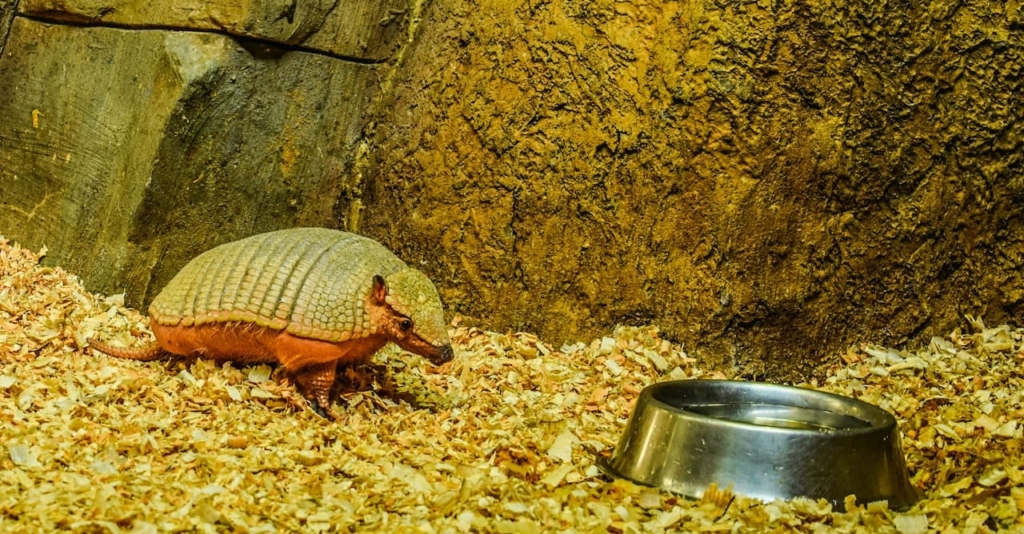
How To Trap An Armadillo
Trapping armadillo can be done using live animal traps. Place the trap near the entrance of their burrow or along their common paths. Bait the trap with food such as worms, insects, or fruit. Once trapped, you can release the armadillo in a suitable location away from human habitation.
What Is The Habitat Of An Armadillo
Armadillos are adaptable animals found in various habitats. They prefer areas with loose soil that allows them to dig easily. This includes grasslands, forests, savannas, and scrublands. They can also be found in urban areas with suitable conditions.
Are Armadillos Blind
While armadillo do not have the best vision, they are not completely blind. Their eyes are small, and their vision is more adapted to low light conditions. They rely more on their sense of smell and hearing to navigate their surroundings.
Do Armadillos Hibernate
Armadillos do not hibernate. They are active throughout the year and make adjustments to their behavior to cope with changing weather conditions.
How Do Armadillos Spread Leprosy To Humans
The transmission of leprosy from armadillos to humans is not entirely clear, but it may involve close and prolonged contact with infected animals or consumption of armadillo meat. The risk of contracting leprosy from armadillo is considered low.
Are Armadillos Endangered
Most armadillo species are not currently considered endangered. However, habitat loss, road accidents, and other factors can impact local populations.
Are There Armadillos In Florida
Yes, armadillos are present in Florida. They have established populations in various parts of the state.
Can Armadillos Swim
Yes, armadillos are capable swimmers. They can cross bodies of water by inflating their stomachs, which helps increase their buoyancy.
Do Armadillos Carry Disease
Armadillos can carry diseases that can be transmitted to humans, such as leprosy and Chagas disease. While the risk of transmission is relatively low, it’s advisable to avoid direct contact with armadillo.
How To Use Vinegar To Get Rid Of Armadillos
There is limited scientific evidence to support the use of vinegar as an effective repellent for armadillos. It’s important to explore alternative methods, such as habitat modification and exclusion techniques.
What Do Armadillos Carry
Armadillos can carry diseases like leprosy and Chagas disease. These diseases can be transmitted to humans through close contact or handling of infected armadillos.
What Does An Armadillo Look Like
Armadillos have a distinctive appearance characterized by their bony, segmented shell that covers their back and sides. They have a pointed snout, small eyes, and long claws on their front feet.
What Does Armadillo Eat
Armadillos have an omnivorous diet that primarily consists of insects and invertebrates such as ants, termites, beetles, and earthworms. They may also consume small vertebrates, amphibians, and fruits.
Where Are Armadillos Found
Armadillos are found throughout the Americas, ranging from the southern United States to South America. They inhabit a variety of ecosystems, including grasslands, forests, and urban areas.
Are There Armadillos In South Carolina
Yes, armadillos have expanded their range into South Carolina and other southeastern states in the United States.
Are There Armadillos In Tennessee
Yes, armadillos have been observed in Tennessee as well as other states in the eastern United States.
Do Armadillos Dig Holes
Yes, armadillos are prolific diggers and use their strong claws to excavate burrows for shelter and foraging.
How To Keep Armadillos Out Of Your Yard
To deter armadillos from your yard, consider removing potential food sources such as insects, installing barriers like fences, and using exclusion methods to prevent access to your property.
Are Armadillos Bulletproof
Armadillos are not bulletproof. While their armored shell provides some protection, they are not invulnerable to bullets or other forms of projectiles.
Are There Armadillos In Sc
Yes, armadillos have been reported in South Carolina and have expanded their range in the southeastern United States.
Can You Have An Armadillo As A Pet
Armadillos are wild animals and are not commonly kept as pets. Their specific care requirements, potential disease transmission, and legality vary by region.
What Does Armadillo Poop Look Like
Armadillo feces can vary in appearance depending on their diet, but it often resembles small, cylindrical pellets. The size and texture can differ based on the armadillo’s food sources.
Are Armadillos Aggressive
Armadillos are generally not aggressive toward humans. They prefer to retreat or dig into the ground when they sense danger.
Are Armadillos Mean
Armadillos are not inherently mean animals. They exhibit natural behaviors to ensure their survival and well-being.
Are Armadillos Poisonous
Armadillos are not poisonous. However, they can carry diseases that may be harmful to humans, so it’s best to avoid direct contact.
Are There Armadillos In Missouri
Yes, armadillos are present in Missouri and have expanded their range to the state.
Do Armadillos Carry Rabies
While armadillos can carry diseases, they are not considered significant carriers of rabies.
How Fast Can A Armadillo Run
Armadillos are not known for their speed. They have a relatively slow pace and often rely on their digging and protective behavior for defense.
Is Piglet A Pig Or An Armadillo
A “piglet” typically refers to a young pig, not an armadillo. Piglets are the offspring of pigs.
Which Armadillos Carry Leprosy
Various armadillo species, especially the Nine-banded Armadillo, have been associated with carrying leprosy-causing bacteria.
Are There Armadillos In Georgia
Yes, armadillos are present in Georgia and have extended their range into the southeastern United States.
Can A Dog Get Leprosy From An Armadillo
The risk of dogs contracting leprosy from armadillos is considered low. Nevertheless, it’s advisable to prevent direct contact between dogs and armadillos.
-
Can Armadillos See?
Armadillos have relatively poor vision and rely more on their sense of smell and hearing to navigate their surroundings.
-
Do Armadillos Have Teeth?
Yes, armadillos have teeth, although they are not well-developed. Their teeth are adapted for their specific diet, which includes insects and soft foods.
-
Can Armadillos Climb?
Armadillos are not proficient climbers. Their anatomy is more adapted for digging than climbing.
Recommended –
Cockatiel Bird | Characteristics, Price, 15 Type, Care Tips, Facts, Health
Love Birds | Information, Price, 15 Types, Facts, Care Tips, Health Issues





























